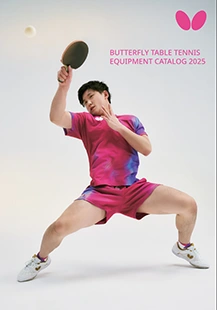[Feature]
[Special feature] America’s star! Jha’s strong points
#3 High toss serve that disrupts the opponent’s rhythm and leads to a quick attack

Kanak Jha (USA) made it to the quarterfinals of the men’s singles at the 2021 World Table Tennis Championships in Houston, and the quarterfinals of the men’s singles at the recent Paris Olympics. At first glance, he plays an orthodox shakehand style, staying up front and not too far from the table, but inside he is packed with a variety of intelligent moves needed to win. In this special feature, we will be looking at Jha’s strengths, including comments from him and his coach, Jorg Bitzigeio (Germany). In the third episode, he explains Jha’s distinctive technique, the high toss serve.
*The technical explanation in the main text is based on a right-handed player.
The pillar of our service is High Service
Jha: My serve is characterized by the fact that I often use the high toss serve. I learned about the high toss serve from my coach, Stefan Feth (former head coach of the US national team), when I was a junior. Stefan’s father-in-law is the former Chinese national team player Li Zhenhuan (1977 and 1981 World Table Tennis Men’s Doubles champion), so I learned it by receiving direct instruction from Li and by imitating him.
The serve is the first ball that gives me control of a rally, so I always think carefully about how to develop the serve afterwards, and I’m confident in my serve, including the development from the serve. However, my coach has pointed out that I still have a long way to go (laughs), so I would like to improve my serve so that I can score more points.
Bitzigeio: From my perspective as his coach, Jha’s serve still has room for improvement. The quality of each serve is not that high. He can combine various spins and courses, so I think the quality of how he uses those serves is high. Jha’s high toss serve is always unsettling because few players use it. And his big strength is that he doesn’t make his opponents think, “That’s a lot of spin,” or “It’s very difficult to receive that serve.” As I mentioned earlier, Jha’s high toss serve is not particularly powerful when you look at each individual serve. However, there are many variations in the toss height and course, and Jha knows well what kind of reception he can expect from each serve and where he can serve it from those variations, and how to connect it to an attack. Therefore, opponents are unknowingly addicted to Jha’s high toss serve.
This is the decisive strength of his serve.

Jha (right) and his coach, Bitzigeio, have been teaming up since 2017.

Li Zhenhuan, a master of the high toss serve, has even appeared on the cover of Table Tennis Report.
High toss underspin short service | High toss topspin long service

Key points for performing a high serve
Jha: With a high toss serve, the ball is thrown high into the air and then falls fast, so there is a risk of missing the ball or losing control. For that reason, you need to practice repeatedly to avoid making such mistakes and learn how to properly control your serve. When I serve with a high toss, I try to hit the ball a little lower than I imagine in my head. If you want to improve your serve, not just with the high toss serve, it’s important to practice while keeping in mind three things: what racket angle to use to hit the ball, where to make the ball take the first bounce, and where to catch the ball.
High toss underspin short service swing

High toss topspin long serve swing

Jha’s high toss serve, which he says was influenced by Li Zhenhuan, the former great player feared around the world as a master of serving from the late 1970s to the early 1980s, does not have the kind of dramatic variation that would cause his opponent to repeatedly make receiving mistakes, but it has excellent control and many variations. Jha’s strong point is using this high toss serve as a starting point for his signature quick attack. The high toss serve, in which the ball is thrown up high, is difficult to control consistently, but on the other hand, it is also very effective in disrupting the opponent’s receipt. Players who want to broaden the range of their serves should definitely give the high toss serve a try, using Jha’s comments and sequence of photos as a reference. In this final installment, we will focus on Jha’s receipt, one of his strong points.
Watch the video here (English subtitles available)
(Interview/Summary = Table Tennis Report)

























